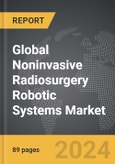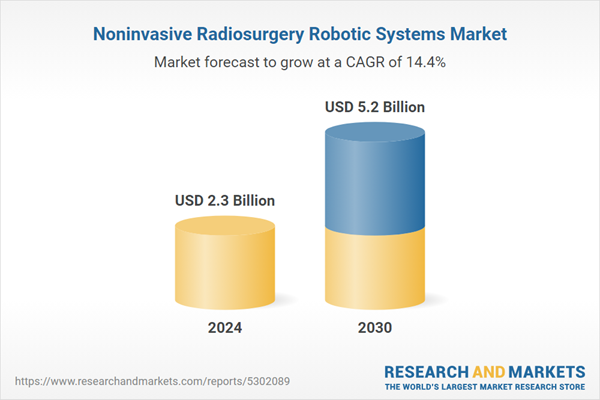Global Noninvasive Radiosurgery Robotic Systems Market - Key Trends and Drivers Summarized
How Are Noninvasive Radiosurgery Robotic Systems Revolutionizing Healthcare?
Noninvasive radiosurgery robotic systems are at the forefront of modern medical technology, offering a precise and less invasive alternative to traditional surgical procedures for treating tumors and other abnormalities. Unlike conventional surgery, radiosurgery does not involve making any incisions; instead, it uses focused beams of radiation to target and destroy abnormal tissues, such as cancerous cells. These robotic systems enhance the precision of the radiation delivery process by integrating advanced imaging technologies, such as MRI or CT scans, which help in mapping the exact location of the tumor. The robotic arm is then programmed to deliver highly concentrated radiation beams with millimeter accuracy, sparing surrounding healthy tissues. One of the most well-known examples of these systems is the CyberKnife, which is capable of treating tumors in the brain, spine, lungs, liver, and other areas where traditional surgery might be risky or impractical. The noninvasive nature of this approach means that patients can often undergo treatment without anesthesia, experience fewer side effects, and recover much more quickly than they would after conventional surgery, making these systems a powerful tool in modern oncology and other medical fields.What Technologies Power the Accuracy and Efficiency of Radiosurgery Robotic Systems?
Noninvasive radiosurgery robotic systems are built upon a fusion of advanced technologies that ensure the utmost accuracy and effectiveness in targeting tumors. At the core of these systems is robotic precision, which allows the radiation beams to be directed from multiple angles, increasing the concentration on the tumor while minimizing exposure to healthy tissues. This capability is made possible by integrating real-time imaging techniques, such as stereotactic imaging, which allows for continuous monitoring of the tumor's position throughout the procedure. This is particularly important in areas like the lungs, where tumors can move as the patient breathes. The combination of robotics and sophisticated imaging provides dynamic tracking of the tumor, ensuring that the radiation remains focused on the target, even if the tumor shifts slightly. Furthermore, these systems employ sophisticated software algorithms to calculate the optimal radiation dose and its distribution, tailoring the treatment to the specific characteristics of the tumor and the patient's anatomy. The introduction of artificial intelligence (AI) into radiosurgery systems has enhanced their capability to adapt to complex cases, improving treatment outcomes by learning from previous procedures. These technologies collectively allow for treatments that are not only more precise but also faster, enabling medical professionals to perform radiosurgery on tumors that would have previously required more invasive procedures or might have been deemed inoperable.How Are Noninvasive Radiosurgery Robotic Systems Transforming Patient Care?
The advent of noninvasive radiosurgery robotic systems has significantly transformed patient care, particularly in oncology, by offering a less invasive, more precise alternative to traditional surgical methods. For patients with cancerous tumors or other difficult-to-treat abnormalities, these systems provide an option that reduces many of the risks and complications associated with open surgery. For example, radiosurgery is particularly beneficial for patients with tumors in sensitive or hard-to-reach areas such as the brain or spine, where conventional surgery might pose a significant risk to neurological function or result in long recovery times. Radiosurgery robotic systems allow physicians to treat these conditions without cutting into the body, leading to fewer side effects, such as infections, and reduced recovery periods. This is especially important for older patients or those with underlying health conditions, who may not be able to withstand the stress of traditional surgery. The outpatient nature of many radiosurgery procedures also means that patients can often return home the same day, reducing the overall cost and time spent in the hospital. Additionally, radiosurgery is now being used to treat non-cancerous conditions such as trigeminal neuralgia, arteriovenous malformations, and even epilepsy, expanding the benefits of these systems to a broader patient population. The versatility and precision of these systems are also enhancing the overall patient experience, offering less traumatic treatment options while maintaining, and often improving, clinical outcomes.What's Driving the Growth of the Noninvasive Radiosurgery Robotic Systems Market?
The growth in the noninvasive radiosurgery robotic systems market is driven by several critical factors that are transforming both healthcare delivery and the technology itself. One of the most significant drivers is the increasing prevalence of cancer and neurological disorders worldwide. As the global population ages, the incidence of diseases like cancer particularly brain and lung cancers, continues to rise, fueling the demand for precise, effective treatment options like radiosurgery. The growing preference for minimally invasive procedures among both patients and healthcare providers is another key factor driving market growth. Patients are increasingly seeking treatments that offer shorter recovery times, fewer complications, and a lower risk of infection, all of which are hallmark benefits of noninvasive radiosurgery systems. Furthermore, technological advancements are continuously improving the precision, efficiency, and safety of these systems. The integration of AI and machine learning is enhancing the ability of these systems to deliver personalized treatment plans, optimizing radiation doses for individual patients and improving clinical outcomes. In addition, the expansion of image-guided radiation therapy (IGRT) is providing even more accurate real-time tracking of tumor movement, making radiosurgery applicable to a wider range of conditions. Another driver is the growing adoption of radiosurgery systems in outpatient settings and smaller clinics, which is made possible by the development of more compact and affordable systems that do not require large-scale infrastructure investments. Moreover, favorable reimbursement policies and increased healthcare spending in emerging markets are expanding access to this technology, making it a viable treatment option for more patients worldwide. As the medical community continues to shift toward precision medicine, the demand for noninvasive radiosurgery robotic systems is expected to rise, driven by the need for treatments that offer high efficacy with minimal disruption to the patient's life.Report Scope
The report analyzes the Noninvasive Radiosurgery Robotic Systems market, presented in terms of market value (US$ Thousand). The analysis covers the key segments and geographic regions outlined below.- Segments: Segment (Noninvasive Radiosurgery Robotic Systems).
- Geographic Regions/Countries:World; United States; Canada; Japan; China; Europe (France; Germany; Italy; United Kingdom; Spain; Russia; and Rest of Europe); Asia-Pacific (Australia; India; South Korea; and Rest of Asia-Pacific); Latin America (Argentina; Brazil; Mexico; and Rest of Latin America); Middle East (Iran; Israel; Saudi Arabia; United Arab Emirates; and Rest of Middle East); and Africa.
Regional Analysis
Gain insights into the U.S. market, valued at $598.8 Million in 2024, and China, forecasted to grow at an impressive 19.3% CAGR to reach $1.3 Billion by 2030. Discover growth trends in other key regions, including Japan, Canada, Germany, and the Asia-Pacific.Why You Should Buy This Report:
- Detailed Market Analysis: Access a thorough analysis of the Global Noninvasive Radiosurgery Robotic Systems Market, covering all major geographic regions and market segments.
- Competitive Insights: Get an overview of the competitive landscape, including the market presence of major players across different geographies.
- Future Trends and Drivers: Understand the key trends and drivers shaping the future of the Global Noninvasive Radiosurgery Robotic Systems Market.
- Actionable Insights: Benefit from actionable insights that can help you identify new revenue opportunities and make strategic business decisions.
Key Questions Answered:
- How is the Global Noninvasive Radiosurgery Robotic Systems Market expected to evolve by 2030?
- What are the main drivers and restraints affecting the market?
- Which market segments will grow the most over the forecast period?
- How will market shares for different regions and segments change by 2030?
- Who are the leading players in the market, and what are their prospects?
Report Features:
- Comprehensive Market Data: Independent analysis of annual sales and market forecasts in US$ Million from 2024 to 2030.
- In-Depth Regional Analysis: Detailed insights into key markets, including the U.S., China, Japan, Canada, Europe, Asia-Pacific, Latin America, Middle East, and Africa.
- Company Profiles: Coverage of players such as Accuray, Health robotics S.R.L., Intuitive Surgical Inc, Mako Surgical Corp, Reninshaw Plc. and more.
- Complimentary Updates: Receive free report updates for one year to keep you informed of the latest market developments.
Some of the 34 companies featured in this Noninvasive Radiosurgery Robotic Systems market report include:
- Accuray
- Health robotics S.R.L.
- Intuitive Surgical Inc
- Mako Surgical Corp
- Reninshaw Plc.
- Varian
This edition integrates the latest global trade and economic shifts into comprehensive market analysis. Key updates include:
- Tariff and Trade Impact: Insights into global tariff negotiations across 180+ countries, with analysis of supply chain turbulence, sourcing disruptions, and geographic realignment. Special focus on 2025 as a pivotal year for trade tensions, including updated perspectives on the Trump-era tariffs.
- Adjusted Forecasts and Analytics: Revised global and regional market forecasts through 2030, incorporating tariff effects, economic uncertainty, and structural changes in globalization. Includes historical analysis from 2015 to 2023.
- Strategic Market Dynamics: Evaluation of revised market prospects, regional outlooks, and key economic indicators such as population and urbanization trends.
- Innovation & Technology Trends: Latest developments in product and process innovation, emerging technologies, and key industry drivers shaping the competitive landscape.
- Competitive Intelligence: Updated global market share estimates for 2025, competitive positioning of major players (Strong/Active/Niche/Trivial), and refined focus on leading global brands and core players.
- Expert Insight & Commentary: Strategic analysis from economists, trade experts, and domain specialists to contextualize market shifts and identify emerging opportunities.
Table of Contents
Companies Mentioned (Partial List)
A selection of companies mentioned in this report includes, but is not limited to:
- Accuray
- Health robotics S.R.L.
- Intuitive Surgical Inc
- Mako Surgical Corp
- Reninshaw Plc.
- Varian
Table Information
| Report Attribute | Details |
|---|---|
| No. of Pages | 130 |
| Published | December 2025 |
| Forecast Period | 2024 - 2030 |
| Estimated Market Value ( USD | $ 2.3 Billion |
| Forecasted Market Value ( USD | $ 5.2 Billion |
| Compound Annual Growth Rate | 14.4% |
| Regions Covered | Global |









